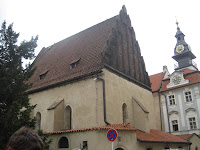While my friend Brad and I were walking towards the Saint Charles Bridge in Prague, we noticed a crowd of people gazing over the city atop a beautiful gothic style tower known as the Old Town Hall Tower, which was constructed in 1338. We knew that Prague has long been known for its vast amount of picturesque spires that are scattered around the beautiful city, so we were dying to get a bird’s eye view of these wonders of the world.

When we finally reached the top of the long, curling pathway and gazed out over the city, the first thing that caught my eye was the myriad of different architecture styles that cluttered the city. After I snapped a few pictures using the panoramic setting on my camera, I glanced at a few pictures on the wall with short descriptions of many of the most prominent buildings in the city. These descriptions gave great information about when the buildings were constructed and the architectural style that each building belonged to. The different types of architecture help to show the history of the city of Prague and how it has transformed over the centuries.
I glanced out over the horizon and saw examples of Romanesque, Gothic, Renaissance, Baroque, and modern architecture that surrounded this beautiful city. Many of the buildings in Prague are made in the gothic style because Prague became the capital of the Holy Roman Empire in the fourteenth century when gothic style was the main form of architecture. Saint Charles IV arranged for construction of many of the most recognizable structures in Prague including the Saint Charles Bridge and the Prague Castle, which is in the Guinness Book of World Records for the largest castle in the world. Surrounding the city were all of the modern skyscrapers that were built outside the city center so that the historical churches, castles, and towers would not be overpowered by modern buildings.
After Brad and I left the Old Town Hall Tower and met up with our friend Dave, we made our short walk to the most recognizable piece of gothic architecture in Prague, the Saint Charles Bridge.

The bridge spans across the Vltava River and is located in the heart of the city. Since water is excellent for transportation and trading of goods, it is obvious why the Saint Charles Bridge is located in the center of the city and why Prague has remained such a large and world-renowned city. The bridge is lined with 30 statues standing on parapets (15 on each side). When walking across the bridge, we couldn’t help but notice tourists walking past the statue of St. John of Nepomuk and rubbing a small section of shiny bronze located in the middle of the statue. Legend has it that if you place your five fingers on the five stars and make a wish, it will come true. At the time, however, my friends and I were unaware of the legend and only touched the stars without making a wish. I recommend that if you visit Prague, don’t forget to make a wish!

It was at this point when I was standing in the middle of the bridge and taking about the thousandth picture of my trip that I remember really taking in the city and getting a feel of the reality that I was in Prague. The smell of the river, the incredible architecture that surrounded me, the sounds of musicians playing, and the sights of local artists lining the bridge gave me something that I will remember forever. I never knew if or when I would be back to visit this beautiful city so I decided to just stand there and take in the extraordinary view overlooking the river. It gave me the chance to experience Prague first hand and gave me a feeling that you can’t get when looking at pictures or reading about this amazing city.




